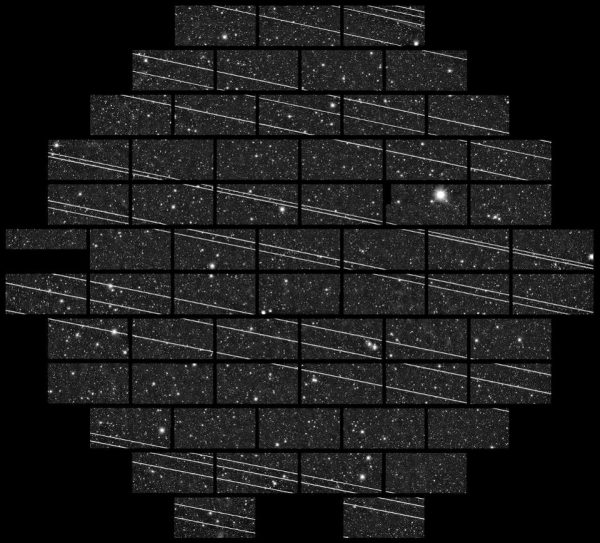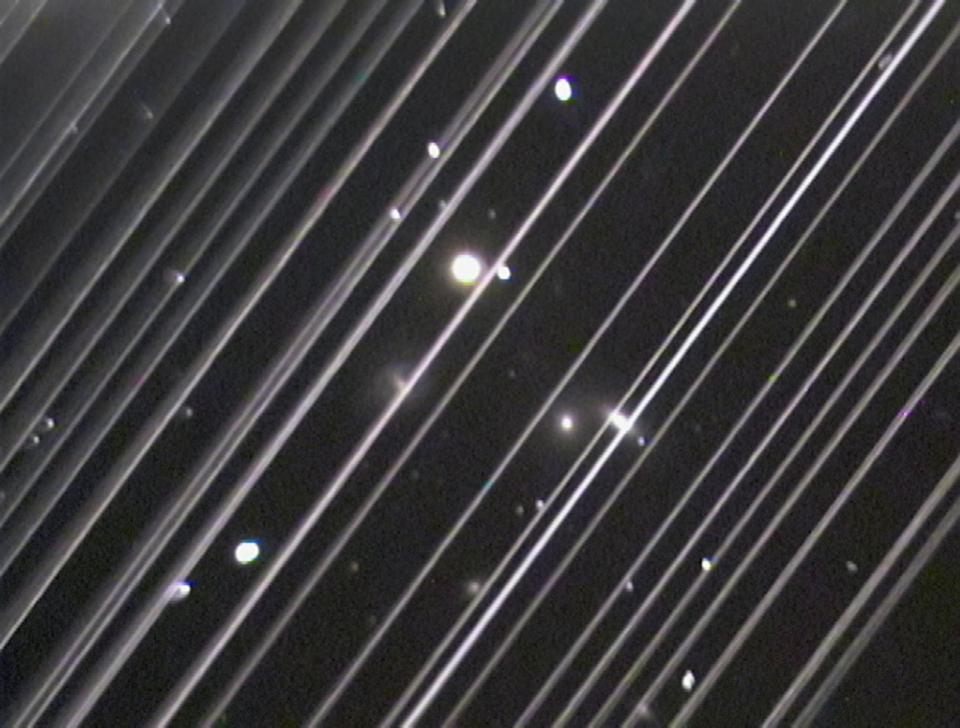Human Heritage Is At Risk If SpaceX Starlink Satellites ‘Saturate’ Big Telescopes, Say Astronomers – Forbes

Around 19 Starlink satellites were imaged shortly after launch in November 2019 by DECam on the … [+] Blanco 4-meter telescope at the Cerro Tololo Inter-American Observatory (CTIO) by astronomers Clara Martínez-Vázquez and Cliff Johnson. The gaps in the satellite tracks are due to the gaps between the DECam CCD chips.
NSF’s National Optical-Infrared Astronomy Research Laboratory/CTIO/AURA/DELVE
The uncontaminated dark night sky should be considered a non-renounceable world human heritage, and satellites from mega-constellations could “saturate” modern detectors on large telescopes, threatening technological progress. That’s according to the International Astronomical Union (IAU), which has issued preliminary results from its research into the effects on astronomy of new satellite mega-constellations in low Earth orbit( LEO).
The IAU has been researching the impact on astronomy and stargazing of SpaceX Starlink satellites—which now number 240, with as many as 1,500 more satellites due to launch in 2020, and as many as 12,000 eventually—since June last year. Amazon, OneWeb (which just launched its first 34 satellites) and others are planning similarly dense mega-constellations in the near future.
So the number of low-flying satellites is about to sky-rocket. Trouble is, they are low AND brighter than expected. That spells trouble for both the naked-eye view of the night sky from dark places, and for astronomers using high-powered telescopes.
There are currently no internationally agreed rules or guidelines on the brightness of orbiting artificial objects, though the IAU plans to present its findings at the meetings of the UN Committee for Peaceful Uses of Outer Space (COPUOS).
“The IAU considers the consequences of satellite constellations worrisome,” reads a statement. “They will have a negative impact on the progress of ground-based astronomy, radio, optical and infrared, and will require diverting human and financial resources from basic research to studying and implementing mitigating measures.”
Based on the input of professional astronomers skilled in modelling the frequency, location and brightness of satellite mega constellations, the IAU has put together some simulations of what the effects of mega-constellations could be.
Here are the early results:
- If there were 25,000 satellites in such mega-constellations, over 1,500 would be above the horizon at any given time.
- Most of these will appear very close to the horizon, only a few of them passing overhead. About 250–300 would have an elevation of more than 30°, and the vast majority would be to fade to be visible to the naked eye.
- During night time when astronomical observations take place—when the sun is 18° below the horizon—around 1,000 satellites could be illuminated, with about 160 of them higher than 30°, so potentially interfering with astronomy.
- There are far fewer problems in the middle of the night, when more satellites are in the Earth’s shadow, so do not reflect sunlight.
- Since SpaceX is working on ways to reduce the reflectivity of its starling satellites by adopting different coatings, it is difficult to predict how many of the illuminated satellites will be visible to the naked eye.
- The density of these satellites is significantly higher in the days after launch, and the satellites diminish in brightness as they reach their final orbital altitude. So the “string of pearls” trains of satellites often seen in images and videos are actually only a problem after launch and during the orbit-raising phase.
- The trails of the satellites will be bright enough to saturate modern detectors on large telescopes, with wide-field observations most severely affected. A big loser looks to be the Rubin Observatory (formerly known as the LSST) in Chile, where it is estimated that about 30% of its long exposure images during twilight will be affected.
- Most big telescopes have a small field of view and will be less affected by mega-constellation satellites, especially those at high altitude on mountain tops where regions of the sky close to the horizon will be less evident.
- One way to mitigate the effect of the new satellites could be by accurately predicting that orbits, and so interrupting observations when necessary as they fly overhead. This could significantly complicate scheduling and operation of observations.
- Data processing could be used to clean images badly affected by the satellites, though this would also increase overheads and complexity.
In its statement the IAU stressed that these early results only apply to optical astronomy, and not radio astronomy, which is still under investigation.

An image of the NGC 5353/4 galaxy group made with a telescope at Lowell Observatory in Arizona, USA … [+] on the night of Saturday 25 May 2019. The diagonal lines running across the image are trails of reflected light left by more than 25 of the 60 recently launched Starlink satellites as they passed through the telescope’s field of view. Although this image serves as an illustration of the impact of reflections from satellite constellations, please note that the density of these satellites is significantly higher in the days after launch (as seen here) and also that the satellites will diminish in brightness as they reach their final orbital altitude.
Victoria Girgis/Lowell Observato
“A great deal of attention is also being given to the protection of the uncontaminated view of the night sky from dark places, which should be considered a non-renounceable world human heritage,” reads the statement from the IAU. “This is one of the main messages communicated on the dedicated IAU-UNESCO web site on astronomical heritage.”
The IAU was also keen to stress the inherent link between the commercial space industry and astronomy. “Technological progress is only made possible by parallel advances in scientific knowledge,” reads the statement. “Satellites would neither operate nor properly communicate without essential contributions from astronomy and physics … it is in everybody’s interest to preserve and support the progress of fundamental science such as astronomy, celestial mechanics, orbital dynamics and relativity.”
Wishing you clear skies and wide eyes.






